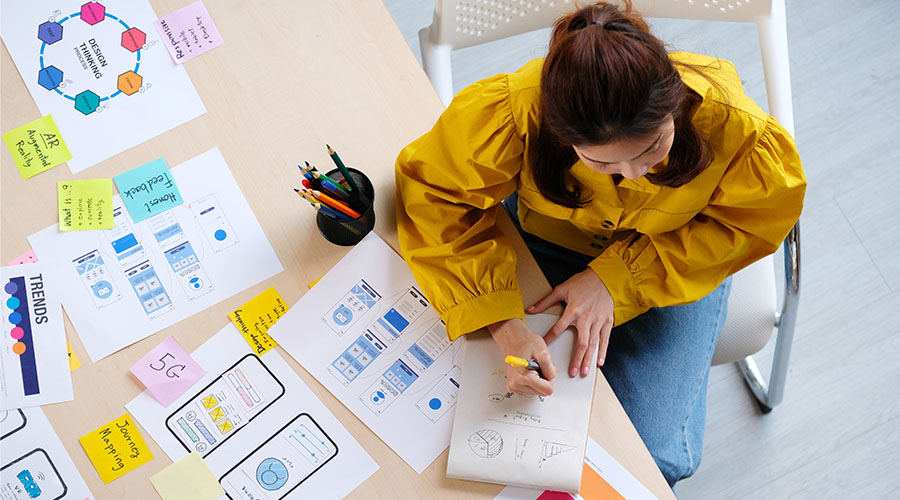The digital world holds many opportunities for creative people who want to use their talents and skills to create new websites, digital products, applications, and software. In addition, there’s an increasing demand for new digital resources and assets, so it’s not so much a question of “can you have a career creating digital assets” as it is “what kind of digital-based design career do you choose?”
That’s why today we’re exploring the basics of a UX design career. This article defines UX design, shows the skills and other requirements for a UX career, what kinds of companies hire UX designers, how you can get certified in UX design, and more.
Let’s start by defining UX design, and then we’ll explore the typical UX designer career path.
What is UX Design?
UX is short for user experience and involves creating extremely user-friendly interfaces that enrich the user’s experience with the product, including real-time usability. A great UX design focuses entirely on the users’ needs, which means the designer must ensure their work conforms to user perceptions and requirements. The UX designer asks, “Who will be using this app or website, what will they want it to do, and how can I make their experience enjoyable and easy?” Once the UX designer does this research, they can design the best possible UX experience.
When people talk about UX design, they often mention UI or User Interface. UI designers are responsible for every visual and interactive element in the product’s interface, including icons, color schemes, responsive design, spacing, and typography.
In summary, UX creates the product’s overall experience and feel and experience, while UI takes care of how the product’s interfaces function. Thus, the UI process is part of the UX. Let’s use an automobile as a UX design example and how it relates to UI. UX is the feeling you get when driving the car, while UI is the engine, steering wheel, transmission, and other mechanical parts. The user experience covers that feeling you get when driving a luxury vehicle. It could include elements like the dashboard or the sound system. After all, those two examples enhance the driver’s experience and convenience.
Also Read: The UX Design Process: Everything You Need to Know
What Skills Do UX Designers Need?
Anyone desiring a UX career must have the proper skills and other prerequisites sewn up. Here are the skills every professional seeking a UX designer career path needs
Hard Skills for a UX Design Career
- UX Writing. This skill covers writing content that balances business goals and user needs, working harmoniously with intuitive UX design, thus giving users the best experience.
- User Research. User experience research systematically investigates your users to collect insights that will guide the design process. Using different user research techniques, the researcher better understands the users’ attitudes, behavior, needs, and pain points.
- Wireframing and Prototyping. Wireframes offer a clear, basic outline of page structure, layout, and the overall direction of the product. In addition, wireframes are essential for gathering critical user feedback, which helps the designer fine-tune the product concept. Finally, a prototype is a scaled-down version of the product, a sample version or simulation created to test the design and its features.
- Visual Communication and UI. Visual communication and UI design skills cover everything from making elements look clickable and minimizing the need for written instructions to white space visual hierarchy.
Soft Skills for a UX Career
- Critical Thinking. Critical thinkers are adept at analysis, evaluation, explanation, inference, interpretation, reflection, observation, problem-solving, and decision-making.
- Empathy. A UX designer who can put themselves in the customers’ shoes and see things from their perspective is a designer who will understand the users’ feelings and anticipate their needs.
- Communication, Collaborative, and Interpersonal Skills. This skill group includes public speaking, presentations, communicating, and working with team members.
- Curiosity and Continuous Learning. Technology is constantly growing and evolving, so a good UX designer always craves to learn new things.
Transferable (non-specific) Skills for a UX Design Career
- Business Acumen. UX designers don’t have to be financial wizards or big business masterminds. Instead, understanding how businesses run, what makes them successful, and how to deal with the competition contributes to creating the best possible products and services.
- Customer Service. It’s all in the name: “User.” Users are customers, and if the UX designer understands customer service and customer relations, that will contribute to the product’s overall success.
- Coding. Most UX designers should have basic coding knowledge since the lines between designers and developers are progressively blurring. Learning coding languages like CSS, HTML, JavaScript, and jQuery can help designers understand what’s feasible from a technological perspective and help smooth the transition between the designer and developer handoff.
- Research Skills and Analytics. AX designers who are good at researching and working with analytics are better equipped to understand what the users want and need. This skill set compliments the empathy soft skill.
Also Read: UI UX Designer Skills: Here’s Everything You Should Know
Is a UX Design Career a Good Fit For You?
So, is a UX design career a good idea? At the risk of sounding like a cop-out and avoiding a solid, definitive answer, it depends on the person. There are as many disciplines found in the UX field as personality types. So, ask yourself these six questions:
- Do you enjoy being analytical and creative? Most professions rely either on creativity or analytical thinking. UX design needs both. UX designers may begin by poring over user analytics and then end up collaborating with UI designers on the product’s components.
- Do you want a career that’s stable and secure? The UX market is healthy, and demand is robust. Many vital UX designer skills are among the most in-demand skills. As long as people visit websites and use apps, there will be a need for UX professionals.
- Are you interested in someday branching out into another vocation? Let’s face it; sometimes, even the most fantastic job can get dull, and it’s time to branch out into something else. However, there’s so much that UX design professionals can do. UX designers need skills in front-end development, voice design, user research, and UX writing, which can open doors to other IT-related careers. Here is a list of jobs related to UX design:
- User Interface Designer
- Product Designer
- Digital Designer
- Designer
- Web Designer
- Lead Designer
- Could you see yourself as a freelancer? Many UX designers get the chance to go freelance. After all, some companies need a UX designer long enough to help design their latest releases. Afterward, well, they probably don’t need them around as much, which can negatively affect job security. But a freelancer, a UX designer who is their own boss, can move from one organization to another, following the work of whatever projects are most important. Just remember to build up a portfolio of your work and create a list of contacts from each place you work for! Those elements are your resume or CV.
- Do you want to help people and make a difference? It’s not overstating the matter to say that UX designers help shape and improve the e-commerce world. UX designers help influence people and directly impact how businesses perform. Additionally, as the UX world increasingly focuses on inclusive design, a growing number of companies and design teams are searching for ways to develop experiences and products that are more inclusive than ever. This trend can have a more significant potential impact on users who typically get excluded due to their abilities, gender, identity, race, or background. So, UX designers can help create a better world for everyone!
- Would you like a healthy annual income? Changing the world is a tremendous and worthwhile purpose, but that doesn’t pay the rent. According to Glassdoor.com, UX designers in the United States earn an annual average of $116,976 per year. The salary range typically ranges from $76K at the low to $183K at the high end.
What Kind of Companies Hire UX Designers?
If you want a UX career, you should become familiar with the types of organizations that typically hire UX designers. According to Glassdoor.com, these are the top industries that hire UX designers.
- Real Estate. $149,477 per year. This figure is 12% higher than other industries.
- Information Technology. $145,912 per year. This figure is 9% higher than other industries.
- Financial Services. $138,525 per year. This figure is 5% higher than other industries.
- Human Resources and Staffing. $133,075 per year. This figure is 1% higher than other industries.
And here is a sample of the top ten companies with openings for UX designers today (March 2023).
- Cisco Systems. $178,680 per year
- Microsoft. $186,313 per year
- IBM. $149,348 per year
- Amazon. $180,040 per year
- Google. $207,494 per year
- Adobe. $175,640 per year
- Deloitte. $114,310 per year
- Capital One. $139,829 per year
- ServiceNow. $156,853 per year
- Walmart. $126,602 per year
Also Read: What’s the Difference Between UI and UX?
Can You Work Remotely as a UX Designer?
Yes, you can absolutely work remotely as a UX designer. The very nature of the profession is conducive to sitting down at a computer and carrying out the necessary work; in many cases, physical location is irrelevant. Thanks partly to the lockdown a few years ago, remote work is more acceptable, and the tools needed to make it function better are more commonplace.
Do You Want a Career in UX Design?
If you’ve decided that you want a UX design career, you must ensure that your skill set is complete, and for that, you need a comprehensive online UI/UX design course to sharpen your knowledge and experience.
Simplilearn, in collaboration with the University of Massachusetts, will get you certified in only five months. This valuable and highly informative design course will teach you how to use the industry’s top design tools (Figma, Invision, Balsamiq, Mural & Sketch) and valuable UI/UX design-related skills like:
- Clickstream Analysis
- Design Thinking
- Empathy mapping
- Gestalt principles
- Information and Interaction Design
- Microcopy
- Persona mapping
- Product Designing
- Prototyping
- UI and Visual Design
- Usability Testing
- User-centered design
- User Experience Design
- Wireframing
So, if you want a rewarding and exciting career that will challenge your analytical skills and creativity while giving you a fantastic way of earning a living and becoming a part of today’s ever-growing IT scene, sign up for this challenging bootcamp, and get that new UX career started. Join today!
You might also like to read:
Essential UX Designer Interview Questions and Answers
What Is a UX Researcher and How To Become One
Excellent UX Design Examples Every Designer Should See







